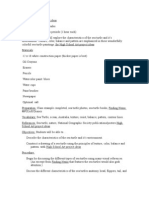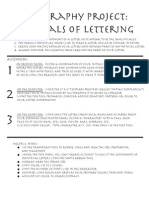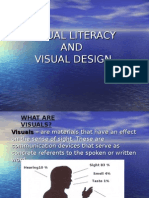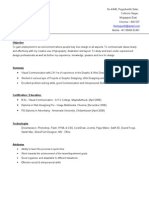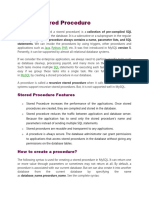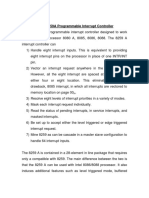0 ratings0% found this document useful (0 votes)
102 viewsElements of Design 1 PDF
Elements of Design 1 PDF
Uploaded by
Michaila Angela UyCopyright:
© All Rights Reserved
Available Formats
Download as PDF, TXT or read online from Scribd
Elements of Design 1 PDF
Elements of Design 1 PDF
Uploaded by
Michaila Angela Uy0 ratings0% found this document useful (0 votes)
102 views28 pagesOriginal Title
Elements-of-Design-1.pdf
Copyright
© © All Rights Reserved
Available Formats
PDF, TXT or read online from Scribd
Share this document
Did you find this document useful?
Is this content inappropriate?
Copyright:
© All Rights Reserved
Available Formats
Download as PDF, TXT or read online from Scribd
Download as pdf or txt
0 ratings0% found this document useful (0 votes)
102 views28 pagesElements of Design 1 PDF
Elements of Design 1 PDF
Uploaded by
Michaila Angela UyCopyright:
© All Rights Reserved
Available Formats
Download as PDF, TXT or read online from Scribd
Download as pdf or txt
You are on page 1of 28
At a glance
Powered by AI
The key takeaways are the different elements of art such as line, shape, color and principles of design.
The different types of lines are outlines, contour lines, expressive lines, sketch lines, calligraphic lines and implied lines.
The categories of shapes are geometric shapes, organic shapes, positive shapes, negative shapes, static shapes and dynamic shapes.
Line: An element of art that is used to define
shape, contours, and outlines, also to
suggest mass and volume. It may be a
continuous mark made on a surface with a
pointed tool or implied by the edges of
shapes and forms.
Characteristics of Line are:
Width- thick, thin, tapering, uneven
Length - long, short, continuous, broken
Direction- horizontal, vertical, diagonal,
curving, perpendicular, oblique, parallel,
radial, zigzag
Focus- sharp, blurry, fuzzy, choppy
Feeling- sharp, jagged, graceful, smooth
Types of Line:
Outlines- Lines made by
the edge of an object or
its silhouette.
Contour Lines- Lines that
describe the shape of an
object and the interior
detail.
Expressive Lines- Line
that are energetic and
catches the movement
and gestures of an active
figure.
Sketch Lines- Lines that captures
the appearance of an object or
impression of a place.
Calligraphic Lines- Greek word
meaning “beautiful writing.” Precise,
elegant handwriting or lettering
done by hand. Also artwork that has
flowing lines like an elegant
handwriting.
Implied Line- Lines that are not
actually drawn but created by a
group of objects seen from a
distance.
Categories of Shapes:
Geometric Shapes-Circles, Squares,
rectangles and triangles. We see
them in architecture and
manufactured items.
Organic Shapes-Leaf, seashells,
flowers. We see them in nature and
with characteristics that are free
flowing, informal and irregular.
Positive Shapes-In a drawing or
painting positive shapes are the solid
forms in a design such as a bowl of
fruit. In a sculpture it is the solid form
of the sculpture.
Categories of Shapes:
Negative Shapes-In a drawing
it is the space around the
positive shape or the shape
around the bowl of fruit. In
sculpture it is the empty shape
around and between the
sculptures.
Static Shape-Shapes that
appears stable and resting.
Dynamic Shape-Shapes that
appears moving and active.
Categories of Color
Color Wheels a tool used to organize
color. It is made up of:
Primary Colors-Red, Yellow, Blue
these color cannot be mixed, they
must be bought in some form.
Secondary Colors-Orange, Violet,
Green, these colors are created by
mixing two primaries.
Tertiary / Intermediate Colors-
Red Orange, Yellow Green, Blue
Violet, etc.; mixing a primary with
a secondary creates these colors.
Analogous colors - The
analog colors are those
colors which lie on either
side of any given color.
Complementary Colors-
are colors that are
opposite each other on
the color wheel. When
placed next to each other
they look bright and when
mixed together they
neutralize each other.
Monochromatic is where one
color is used but in different
values and intensity.
Warm colors are on one side
of the color wheel and they
give the felling of warmth for
example red, orange and
yellow are the color of fire and
feel warm.
Cool colors are on the other
side of the color wheel and
they give the feeling of
coolness for example blue,
violet, are the color of water,
and green are the color of cool
grass.
Categories of Space
Positive space-Like in positive
shape it is the actual sculpture or
building.
Negative space-Also like negative
shape it is the space around the
sculpture or building.
Picture Plane is the flat surface of
your drawing paper or canvas.
Composition is the organization
and placement of the elements on
your picture plane.
Focal Point is the object or area
you want the viewer to look at first.
Types of Perspective
Perspective in the graphic arts, such as drawing,
is an approximate representation, on a flat
surface (such as paper), of an image as it is
perceived by the eye.
Nonlinear Perspective is the method
of showing depth that incorporates
the following techniques.
Position-Placing an object higher
on the page makes it appear
farther back then objects placed
lower on the page.
Overlapping-When an object
overlaps another object it appears
closer to the viewer, and the
object behind the object appears
farther away.
Types of Perspective
Nonlinear Perspective:
Size Variation-Smaller objects
look farther away in the distance.
Larger objects look closer.
Color-Bright colors look like they
are closer to you and neutral
colors look like they are farther
away.
Value-Lighter values look like
they are farther back and darker
value look like they are closer.
Linear Perspective is the method of
using lines to show the illusion of depth
in a picture. The following are types of
linear perspective.
One-point perspective-When lines
created by the sides of tables or
building look like that are pointing to
the distance and they all meet at one
point on the horizon this is one-point
perspective. To see an example stand
in the middle of the hallway and look at
the horizontal lines in the brick or the
corner where the ceiling meets the
wall. See how they move to one point
on the horizon.
Two-point perspective-Here the lines
look like they are meeting at two
points on the horizon line.
Categories of Texture
Real Texture is the actual
texture of an object. Artist
may create real texture in
art to give it visual interest
or evoke a feeling.
Implied Texture is where
a piece of art is made to
look like a certain texture.
Like a drawing of a tree
trunk may look rough but
in fact it is just a smooth
piece of paper
Categories of Values
Tint is adding white to
color paint to create
lighter values such as
light blue or pink.
Shade is adding black to
paint to create dark
values such as dark blue
or dark red.
High-Key is where the
picture is all light values.
Categories of Values
Low-Key is where the
picture is all dark values.
Value Contrast is where
light values are placed
next to dark values to
create contrast or strong
differences.
Value Scale is a scale
that shows the gradual
change in value from its
lightest value, white to
its darkest value black.
Form is the three-dimensionality of an object. Shading a
circle in a certain manner can turn it into a sphere.
Balance means keeping your design like a pattern. A balanced
pattern would be if you had a border on your pattern in black.
Unbalanced would be if approximately one-third of the border was
orange and the other two-thirds in pink. To keep your design
balanced, make your measurements as accurate as possible.
Keeping your design symmetric is a good technique for good
balance.
Unity means keeping your design in a sort of harmony in
which all sections of the pattern make other sections feel
complete. Unity helps the design to be seen as one design
instead of randomness all around your design.
Harmony is similar to Unity. Harmony brings together a
composition with similar units. If your composition was
using wavy lines and organic shapes you would stay with
those types of lines and not put in just one geometric shape.
Pattern is simply keeping your design in a certain format.
For example, you could plan to have curved lines all around
your design as a pattern, but then you must continue those
curved lines throughout the design for good patterns.
Contrast means showing differences in two different sections of the
design or showing somehow that the design being created is very
different from other designs because of its contrast. Contrast can also be
used to show emphasis in any part of the design.
Emphasis is given to an area within the design because that area is
meant to be seen or is more important to be noticed when compared to
other places of the design. For example, the calligraphy in the image
below would be a part on the design that is emphasized.
Movement is the suggestion or illusion of motion in a
painting, sculpture, or design. For example, circles going
diagonally up and down from right to left could show that
the design moves up and to the right or down and to the left.
Rhythm is the movement or variation characterized by the
regular recurrence or alternation of different quantities or
conditions. In simpler words, it's just like pattern and shows
that the design has a 'beat' or 'flow' going with it.
Variety refers to the differences in the work, You can
achieve variety by using difference shapes, textures, colors
and values in your work.
Proportion or scale refers to the relationships of the size of
objects in a body of work. Proportions gives a sense of size
seen as a relationship of objects. such as smallness or
largeness.
Abstract & Surreal are varieties of Art.
Abstract & Art does not reflect any form of conventional
reality, all you see are lines, shapes, colors, & patterns.
Abstraction indicates a departure from reality in depiction of
imagery in art.
Surreal in general means bizarre (marked by the intense
irrational reality of a dream) or dreamlike (unbelievable).
Copyright © 2009 www.digiartport.net
You might also like
- Alyssa Gallagher Kami Thordarson Design Thinking For School LeadersDocument226 pagesAlyssa Gallagher Kami Thordarson Design Thinking For School LeadersКундызNo ratings yet
- High School Art Project IdeasDocument3 pagesHigh School Art Project IdeasVolans100% (2)
- Expressive Hand Pen Ink Drawing RubricDocument2 pagesExpressive Hand Pen Ink Drawing Rubricapi-293228411100% (1)
- Ci-Miniunit-Abstract ArtcolorDocument13 pagesCi-Miniunit-Abstract Artcolorapi-299713215No ratings yet
- New Visual Elements and Principles of DesignDocument128 pagesNew Visual Elements and Principles of DesignStan Hunc100% (1)
- By: Zaiba MustafaDocument29 pagesBy: Zaiba MustafaAr SaRangNo ratings yet
- Avi3m3o1 - 20th Century Art Lesson 2 Cubism - Synthetic 2Document5 pagesAvi3m3o1 - 20th Century Art Lesson 2 Cubism - Synthetic 2api-448816945No ratings yet
- Teaching ArtsDocument18 pagesTeaching ArtsHimaya CamposNo ratings yet
- Art Class Curator Elements and Principles Printable Pack PDFDocument9 pagesArt Class Curator Elements and Principles Printable Pack PDFhelen karm100% (1)
- Printmaking Art Curriculum MapDocument19 pagesPrintmaking Art Curriculum MapMill ValleyNo ratings yet
- Rubric Shom Art Exploration Shoe DrawingDocument1 pageRubric Shom Art Exploration Shoe Drawingapi-201056542100% (1)
- Contour Line RubricDocument1 pageContour Line Rubricapi-244578825No ratings yet
- Fundamentals of 3d ArtDocument13 pagesFundamentals of 3d Artapi-541754489No ratings yet
- Principles and Elements of DesignDocument11 pagesPrinciples and Elements of Designapi-3750482No ratings yet
- The Principles of Art and DesignDocument21 pagesThe Principles of Art and DesignRochelle Ann BoneteNo ratings yet
- Art LessonDocument3 pagesArt Lessonapi-300204783No ratings yet
- Formal Visual AnalysisDocument30 pagesFormal Visual AnalysisHaydee Kristine A. Luzon - LabastillaNo ratings yet
- Full Line Art Unit CompleteDocument6 pagesFull Line Art Unit Completeapi-309866997No ratings yet
- Scratchboard Lesson PlanDocument11 pagesScratchboard Lesson Planapi-251752385No ratings yet
- BalanceDocument7 pagesBalanceapi-180230978No ratings yet
- Principles and Elements of DesignDocument53 pagesPrinciples and Elements of DesignDennie Zody Logan100% (5)
- Printmaking NotesDocument16 pagesPrintmaking Notesapi-279660401100% (1)
- Acrylic Pop Art RubricDocument1 pageAcrylic Pop Art Rubricapi-293964578No ratings yet
- Etymology and Classification of Visual ArtsDocument103 pagesEtymology and Classification of Visual ArtsAnalo TorresNo ratings yet
- Principles of Arts & DesignDocument71 pagesPrinciples of Arts & DesignTrisha Mae BalladNo ratings yet
- History of Design - Sample Course OutlineDocument2 pagesHistory of Design - Sample Course OutlineRicha PantNo ratings yet
- Mark Making Lesson PlanDocument14 pagesMark Making Lesson Planapi-523388033No ratings yet
- AP Art and Design 2d Sustained Investigation Samples 2019 2020Document82 pagesAP Art and Design 2d Sustained Investigation Samples 2019 2020Vessy ChimovaNo ratings yet
- TypographyDocument2 pagesTypographyapi-347022235No ratings yet
- Art Principles of Design NotesDocument2 pagesArt Principles of Design NotesEthanNo ratings yet
- Year 7 Portraits 090615Document9 pagesYear 7 Portraits 090615api-323904546No ratings yet
- Principles of DesignDocument23 pagesPrinciples of DesignKlaus Fruchtnis100% (1)
- Design Chart ExplanationDocument6 pagesDesign Chart ExplanationlukamariaNo ratings yet
- Creating An Illusion With OP Art: Grade Level Subject/Content Area Lesson DurationDocument10 pagesCreating An Illusion With OP Art: Grade Level Subject/Content Area Lesson Durationapi-457786629No ratings yet
- Lesson Plan Art Critiscm FeldmanDocument18 pagesLesson Plan Art Critiscm FeldmanRuru JoyceNo ratings yet
- Unit 2 Otcome 1 Vce RubricDocument2 pagesUnit 2 Otcome 1 Vce Rubricapi-246589904100% (1)
- Art DecoDocument29 pagesArt Decodark_mackaroo04100% (2)
- Typography ExercisesDocument1 pageTypography Exercisesapi-250295080No ratings yet
- What Are The Principles of Art (Or The Principles of Design) ?Document18 pagesWhat Are The Principles of Art (Or The Principles of Design) ?Ngan KimNo ratings yet
- Gesture Drawing Lesson Plan Christine MccormickDocument5 pagesGesture Drawing Lesson Plan Christine Mccormickapi-313503065No ratings yet
- The Elements of Art and Principles of DesignDocument16 pagesThe Elements of Art and Principles of Designapi-500498959No ratings yet
- Contemporary Art Lesson PlanDocument3 pagesContemporary Art Lesson Planapi-386567337No ratings yet
- Art - Choice Board Year 8 - Colour TheoryDocument1 pageArt - Choice Board Year 8 - Colour Theoryapi-375997249No ratings yet
- Semester Overview Arts Visual Arts Year 3 2012Document2 pagesSemester Overview Arts Visual Arts Year 3 2012api-185034533No ratings yet
- Lesson Plan Art Fundamentals 3Document7 pagesLesson Plan Art Fundamentals 3api-490426183No ratings yet
- RubricsDocument4 pagesRubricsAriesNo ratings yet
- Which of These Paintings Has A More Realistic Setting and Why? How Has The Artist Created A Sense of Distance /depth?Document47 pagesWhich of These Paintings Has A More Realistic Setting and Why? How Has The Artist Created A Sense of Distance /depth?Terry TanNo ratings yet
- Ap Studio Art SyllabusDocument7 pagesAp Studio Art Syllabusapi-264467183No ratings yet
- Principles of DesignDocument3 pagesPrinciples of DesignTabish NehaNo ratings yet
- DP Visual Arts ComponentsDocument10 pagesDP Visual Arts ComponentsAlesha Michelle FeisalNo ratings yet
- Visual Literacy and Visual DesignDocument25 pagesVisual Literacy and Visual DesignEzekiel D. Rodriguez100% (1)
- Art Center College of Design Graduate Media Design Program Curriculum Grid and Course Descriptions 2011-12Document6 pagesArt Center College of Design Graduate Media Design Program Curriculum Grid and Course Descriptions 2011-12GradMediaDesignNo ratings yet
- ELEMENTS OF ART & PRINCIPLES OF DESIGNbbDocument7 pagesELEMENTS OF ART & PRINCIPLES OF DESIGNbbSams VimalNo ratings yet
- Elements of Art HandoutsDocument7 pagesElements of Art HandoutsKristinaNo ratings yet
- 5 - FauvismDocument7 pages5 - Fauvismapi-238665396100% (2)
- Pointillism Lesson 400Document17 pagesPointillism Lesson 400api-548946265No ratings yet
- How To CritiqueDocument41 pagesHow To CritiqueCeloSakiNo ratings yet
- MYP4 Unit Plan Essence of A CityDocument2 pagesMYP4 Unit Plan Essence of A CitymiblsartroomNo ratings yet
- Principles and Elements of DesignDocument20 pagesPrinciples and Elements of DesignGlaiza Angel MacapagalNo ratings yet
- AP Studio Art Syllabi 2012Document8 pagesAP Studio Art Syllabi 2012Emily Maxwell McLemoreNo ratings yet
- Elements and Principles of Design HandoutDocument6 pagesElements and Principles of Design HandoutColeen Stenelli ManzanoNo ratings yet
- Aws Docker Spring BootDocument15 pagesAws Docker Spring Bootcontact.me90No ratings yet
- Cyclic Groups and Some of Their Properties - PartDocument5 pagesCyclic Groups and Some of Their Properties - PartSomik MandalNo ratings yet
- Load Test Report: FunstestDocument8 pagesLoad Test Report: FunstestPavankumar RavinuthalaNo ratings yet
- Legacy StructureDocument22 pagesLegacy StructurearnaudlodewyckNo ratings yet
- Mugunthan ResumeDocument4 pagesMugunthan Resumeapi-20007381No ratings yet
- SB en PDFDocument2 pagesSB en PDFPaulo BraggioNo ratings yet
- ICT Sector ProfileDocument24 pagesICT Sector ProfilemecaspirantnepalNo ratings yet
- Mekelle Institute of Technology (MIT) Mekelle, Tigray, EthiopiaDocument6 pagesMekelle Institute of Technology (MIT) Mekelle, Tigray, EthiopiaGemmedaMidaksoNo ratings yet
- 5047 Asm1Document45 pages5047 Asm1honganh22122004No ratings yet
- Cbc-Competency Based Curriculum EpasDocument91 pagesCbc-Competency Based Curriculum EpasMapili Amigo Gen100% (1)
- SCCM PDFDocument12 pagesSCCM PDFShivakumar S KadakalNo ratings yet
- POLAR INSTRUMENTS Toneohm 950 OperationDocument44 pagesPOLAR INSTRUMENTS Toneohm 950 OperationMustafa PekerNo ratings yet
- Eh Unit 3Document15 pagesEh Unit 3tixove1190No ratings yet
- CSC 201 Course MaterialDocument18 pagesCSC 201 Course MaterialDavid OmaguNo ratings yet
- Nota PenjualanDocument46 pagesNota PenjualanTaufik HidayatullahNo ratings yet
- TEC Annexures To ER - Aug2021Document221 pagesTEC Annexures To ER - Aug2021srinivasa B RNo ratings yet
- MySQL Stored Procedure and TriggersDocument96 pagesMySQL Stored Procedure and TriggersVaishnaviNo ratings yet
- Lecture 2Document22 pagesLecture 2Mohit GargNo ratings yet
- 0000 - LeibingerJet2SE Release 3.00 - en - 090707 - HerstelleranleitungDocument179 pages0000 - LeibingerJet2SE Release 3.00 - en - 090707 - HerstelleranleitungAnonymous CSnweOxNo ratings yet
- 2304-PT-JKV-073-Frozen Plant Temp Monitoring System - Amul MogarDocument5 pages2304-PT-JKV-073-Frozen Plant Temp Monitoring System - Amul MogarjaydeeppanchalNo ratings yet
- OpenCore 0.6.0 DifferencesDocument29 pagesOpenCore 0.6.0 Differencespolaris44No ratings yet
- XII CS Term1 Preboard Combined 2021payalDocument252 pagesXII CS Term1 Preboard Combined 2021payalmalathi0% (1)
- GIs Technology and Application On Oil-Gas Pipeline ConstructionDocument5 pagesGIs Technology and Application On Oil-Gas Pipeline ConstructionsachinNo ratings yet
- Connecting Cable & ConnectorsDocument26 pagesConnecting Cable & Connectorssanderaprima2No ratings yet
- 2 Software InstallationDocument13 pages2 Software Installationhsalas2112No ratings yet
- Daily Expense Tracker PDFDocument188 pagesDaily Expense Tracker PDFAnkitmauryaNo ratings yet
- Lecture-51 INTEL 8259A Programmable Interrupt ControllerDocument7 pagesLecture-51 INTEL 8259A Programmable Interrupt ControllerSahil KKNo ratings yet
- UntitledDocument3 pagesUntitledThirdyOjelaNo ratings yet
- Data Cleaning and Base SAS Functions: Caroline Bahler, Meridian Software IncDocument6 pagesData Cleaning and Base SAS Functions: Caroline Bahler, Meridian Software IncBhavana_CMNo ratings yet

